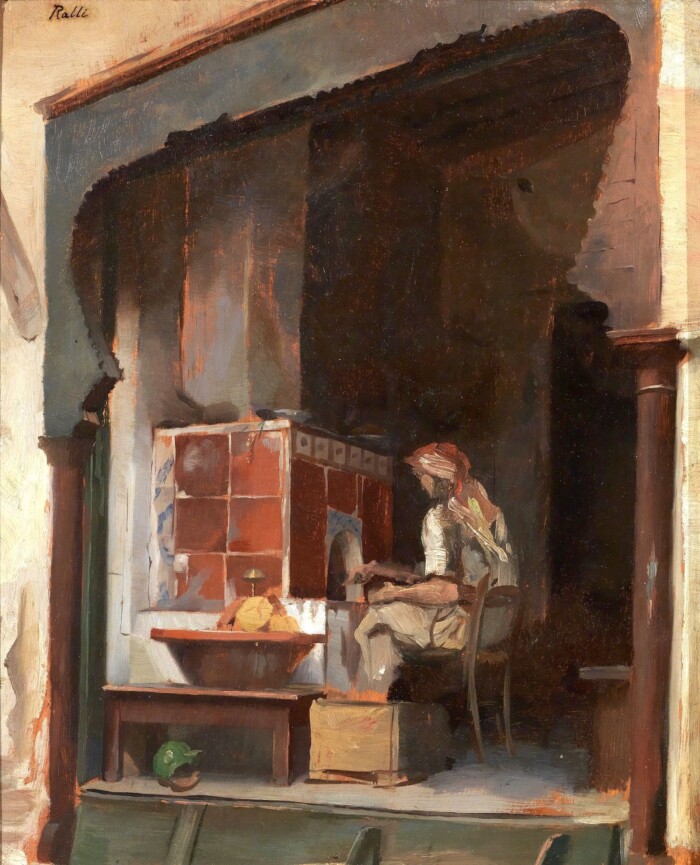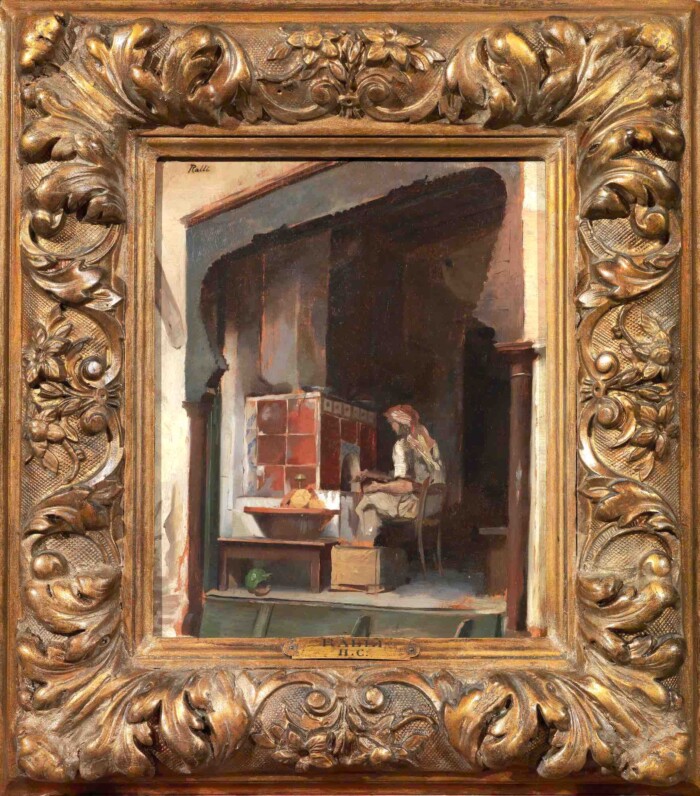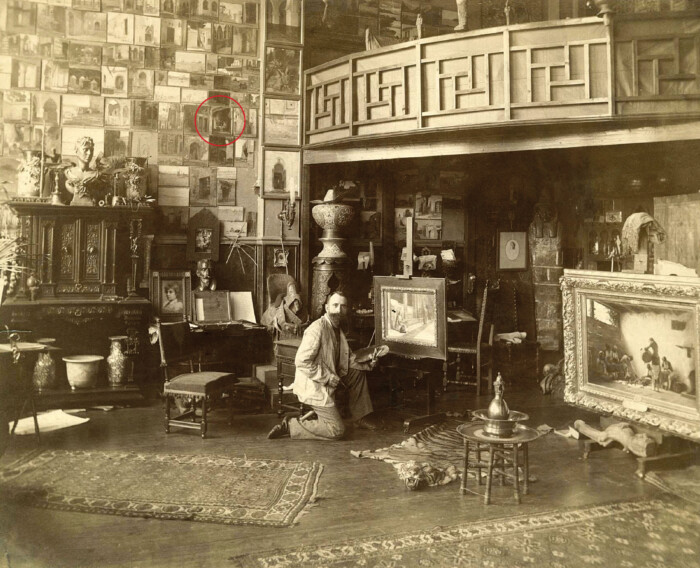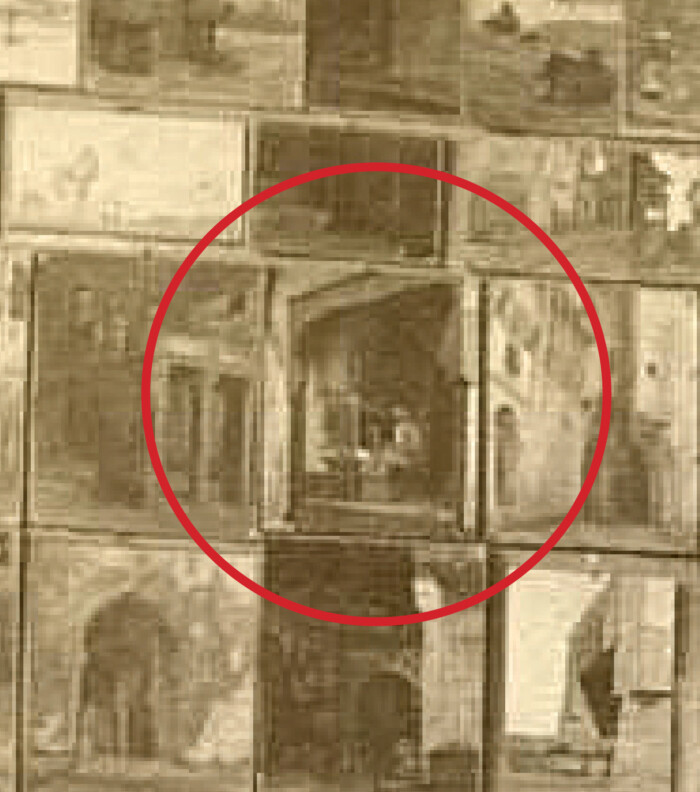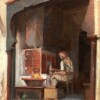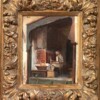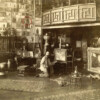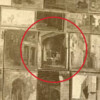| 06 |
Greek, 1852-1909
Restaurant a Smyrne
oil on panel
signed upper left
titled on the reverse
29.8 x 24.5 cm
PROVENANCE
private collection, Athens
NOTE
The work is exhibited in Ralli’s Parisian studio in a period photograph.
The work bears a period exhibition sticker with the name of the artist and title on the reverse.
| sold for 17,677.50 € |
Art historians tend to identify two broad types of oriental artists: the realists who carefully painted what they observed during their travels to the Orient and those who imagined orientalist scenes without ever leaving the studio.
Also, the artists that did travel to the Orient created mostly works exaggeratingly exotic, colorful, and sensual. They combined real elements of the Orient with western elements creating imaginary scenes with a polished technique.
In ‘Restaurant a Smyrne’ Ralli paints the reality of what he observed in one of his travels to Asia Minor and more specifically to Smyrne: he focuses on a simple woman working in front of a stove, set within an oriental interior. He paints what he sees without beautifying or exaggerating his subject.
The light graduation from the bright outside to the adequately lit foreground and the dim background of the interior intensifies the everyday humble subject he chooses to paint. Ralli successfully transfers to the spectator the dedication the female figure has to the simple task she performs: cooking.
Theodore Jacques Ralli was born in Constantinople in 1852, into a grand old family that descended from the island of Chios.
Although the young Theodore showed an early inclination towards painting, his family environment channeled his studies in the business field to work in the family business.
After completing his secondary education at the Theological School of Halki he continued his studies in London. Soon he realized his great love for painting and decided to change his carrier route. In 1870 he was already in France and after a short stay at Marseilles he settled down in Paris. Between 1872/1873 and 1880 he studied painting with the great orientalist Jean-Leon Gerome.
In 1873 he exhibited at the Salon des Refuses and two years later he was accepted to exhibit at the prestigious Salon de Paris where he exhibited until the end of his life (Salon des Artistes Vivants 1875-1880, Exposition de la Societe des Artistes Francais 1881-1909).
His visit to Greece in the Spring of 1876 inspired the paintings he exhibited the next year in Paris; the works with Greek subjects were highly praised by the French critics. Simultaneously he painted works of Oriental subjects.
The fact that Ralli had roots in Constantinople urged him to travel yearly to places like Mount Athos, Egypt, Palestine, Algeria, Syria, and Asia Minor. He returned to Paris with sketches or even photography that helped him to compose his paintings. Additionally, he traveled around Europe to study the masterpieces in the Museums as well as the art of his contemporaries.
He exhibited extensively in Europe and especially in the United Kingdom, which at the time was the main market for Oriental works: at the Royal Academy of Arts, London between 1879-1883, and also in Liverpool, Manchester, and Glasgow. Additionally, he exhibited in Brussels (1887), Ghent (1892), and from 1881 onwards in the French province.
In 1885 he became a French citizen and in the same year was awarded the ‘Order of the Saviour’ in Greece. In 1900 he was awarded the ‘Officer in the Honorary Legion' by the French government.
Like other Greek artists living abroad, he kept close links with Greece by exhibiting regularly in Athens: Zappeion in 1896, 1898, 1899, 1908, 1909, and Parnassos in 1901 and 1903.
Ralli kept a studio in Cairo where he spent the winter months from the late 1880s to 1904. He taught painting and drawing and was greatly involved in the local art scene. It was by his initiative that the Cairo Exhibition was organized from 1891 onwards that was of great success, especially within the foreign community of the city. In 1896 he participated in the first Alexandria Exhibition.
In 1881 he wed Ioulia Mavrokordatos, in London and one year later they had their only daughter Ina (Aikaterina). Sadly, his wife died in 1888 at the young age of 29. His second marriage in 1895 with Maria Mavromichalis ended in divorce.
Ralli was a cosmopolitan man, a ‘man of the world’, highly respected in the French artistic circles and with close friendship bonds with men of intellect and well-known artists such as Jean-Joseph Benjamin Constant and Jean-Jules-Antoine Lecomte du Nouy. He donated the amount of 15000 francs to the Societes des Artistes Francais to establish an award for new artists entering the Salon, an award that is awarded until today.
His work is found in many public and private collections, notably: The National Gallery of Greece, the Leventis Gallery, the Averoff Gallery, the Koutlides Collection, and the Katsigras Art Collection.
